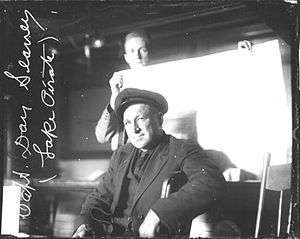Dan Seavey
Dan Seavey, also known as "Roaring" Dan Seavey, (March 23, 1865 – February 14, 1949) was a sailor, fisherman, farmer, saloon keeper, prospector, U.S. marshal, thief, poacher, smuggler, hijacker, human trafficker, and timber pirate in Wisconsin and Michigan and on the Great Lakes in the late-19th to early-20th century.
Dan Seavey | |
|---|---|
 Dan Seavey, 1920 | |
| Born | March 23, 1865 |
| Died | February 14, 1949 (aged 84) |
| Resting place | Forest Home Cemetery, Marinette, Marinette County, Wisconsin |
| Nationality | American |
| Other names | "Roaring" Dan Seavey |
| Occupation | sailor, fisherman, farmer, saloonkeeper, prospector, U.S. marshal, thief, poacher, smuggler, hijacker, human trafficker, lake pirate |
| Known for | For lake piracy, in Wisconsin and Michigan, on the Great Lakes, from the late 19th-early 20th century |
Early life
Seavey was born in Portland, Maine, on March 23, 1865.[1] He left home at age 13 and became a sailor,[2] serving for a short time in the United States Navy.[3] He moved near Marinette, Wisconsin in the late 1880s, where he married Mary Plumley and had two daughters.[2][4] The family later moved to Milwaukee, Wisconsin, where Seavey fished, farmed and owned a local saloon. In 1898, Seavey left his family in Milwaukee to participate in the Klondike Gold Rush.[2] He was unsuccessful, and returned to the Great Lakes region around 1900.
Pirate
In poverty, Seavey moved to Escanaba, Michigan and acquired a schooner, which he named the Wanderer, and began a career as a pirate.
Seavey sailed the Wanderer as a legitimate shipping operation, but also sailed into ports at night to steal cargo from other vessels and warehouses.[2] Seavey also kidnapped or transported women in the illegal prostitution trade, an early form of human trafficking and sex trafficking.
Seavey was notorious for altering sea lights, either by extinguishing existing lights or placing false lights. The trick, known as "moon cussing", would cause ships to sail into rocks, where Seavey's crew could easily capture the cargo from the wounded vessel.[3]
A significant amount of Seavey's profit was made from venison poaching. When a company called Booth Fisheries attempted to compete with Seavey's illegal venison trade, Seavey attacked one of its ships with a cannon, killing everyone on board.[3]
Seavey's most infamous exploit was the hijacking of the schooner Nellie Johnson. On 11 June 1908,[5] Seavey came aboard in Grand Haven, Michigan with a large amount of alcohol, which he offered to share with the crew. Once they became intoxicated, Seavey tossed them overboard and sailed the Nellie Johnson to Chicago, where he sold the cargo.[3][6] The United States Revenue Cutter Service soon gave chase in the Tuscarora. Seavey, meanwhile, had moored the Nellie Johnson and was again sailing in the Wanderer. After several days, he was captured on June 29, 1908.[7] and taken to Chicago in irons.[2]
Arrest
Seavey was arrested on the charge of piracy,[8] but was officially charged with "unauthorized removal of a vessel on which he had once been a seaman".[2] He was released on bond and the charges were later dropped when the owner of the Nellie Johnson failed to appear.[3] For the rest of his life, Seavey maintained that he won the Nellie Johnson in a poker game.[2]
Later life and death
At the end of his career, Seavey accepted a position with the United States Marshals Service, where he worked to curb poaching, smuggling, and piracy on Lake Michigan.[3]
The Wanderer was destroyed by fire in 1918 and Seavey purchased a 40-foot motor launch. It's unclear if he continued as a marshal or an outlaw, or both, but motor launches were a favorite of Great Lakes smugglers when Prohibition began in 1919.[2]
Seavey retired in the late 1920s and settled in Peshtigo, Wisconsin. He died at the Eklund nursing home in Peshtigo on February 14, 1949 at the age of 84.[1] Seavey is buried next to his daughter in Forest Home Cemetery, Marinette, Marinette County, Wisconsin.[2]
In popular culture
The Great Lakes Distillery, in Milwaukee, Wisconsin, distills a rum, called "Roaring Dan's Rum", paying homage to the pirate.[9]
Dan Seavey appears as a character in a Season 12 episode of Murdoch Mysteries.
His history and treasure are the focus of Warehouse 13 in season 4 episode "Lost & Found".
References
- "Cap'n Dan Seavey Dies at 83, Ending Colorful Career on Great Lakes". The Escanaba Daily Press. 25 February 1949. p. 2. Retrieved 10 December 2014 – via Newspapers.com.

- Bie, Michael (2009). "The Life & Crimes of Dan Seavey". ClassicWisconsin.com. Archived from the original on 25 August 2013.
- Sandusky, link below
- Peterson, Lana. 1995. "Dan Seavey of Garden and Fayette Was Known as the Great Lakes Pirate." The Manistique Pioneer-Tribune, (22 June).
- Criminal Justice Resources: Michigan's Only Pirate Archived 18 February 2012 at the Wayback Machine
- There is some dispute about whether Seavey was able to sell the cargo. See Arrrr! Real Pirates Once Sailed On Lake Michigan. Some Even Plundered The Shores Of Chicago Website accessed 3 August 2009.
- SHOT STOPS A LAKE "PIRATE."; Revenue Cutter Captures a Mariner After Seven Days' Chase. The New York Times, June 30, 1908. Retrieved May 22, 2017.
- Seavey was the only man to ever be arrested for piracy on the Lake Michigan. Criminal Justice Resources :Michigan's Only Pirate Archived 18 February 2012 at the Wayback Machine
- Roaring Dan's Rum by Great Lakes Distillery Archived July 13, 2013, at the Wayback Machine
External links
- Dan Seavey - Michigan's Only Pirate? at Michigan State Libraries
- Great Lakes Pirate Dan Seavey and the Schooner Wanderer from the Washington Island Observer
